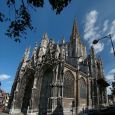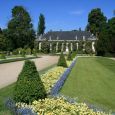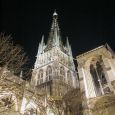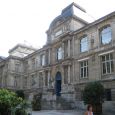Rouen
Advertisement
By train
Several trains depart from the St Lazare Station in Paris for Rouen on a daily basis. Tickets cost around 20 euros and can be purchased at the station immediately beforehand. Travel time is about 1hr 15min.
Note that the train posting in Paris St-Lazare can be confusing to the first time traveler. The train platform number ("la voie") is not posted unil 15-20 minutes before the departure, so do not panic if you arrive earlier than that. Look for the train heading to Le Havre. Do not forget to punch ("composter") your ticket in one of the yellow machines before boarding. This will validate your ticket.
By plane
Rouen's airport has limited connections with various cities.
By boat
from UK : see Dieppe, Le Havre, etc., above. For foot-passengers, the train and ferry journey from London via Newhaven and Dieppe is one of the most pleasant and restful ways of getting to Rouen.
By car
From Paris, Rouen is approximately an hour and a half's drive (135 km) north-west from the centre of the French capital, the fastest route including the A13 motorway (note: this a toll road). An alternative route would include the N14 slightly further to the north.
From the Channel port city of Dieppe, Rouen is approximately an hour's drive (66 km) south along the N27.
From the French end of the Eurotunnel, Rouen is approximately a 2 hour drive (208 km) using the E402.
From other major centres in Normandy, Rouen is respectively 90 km (1 hr 10 mins) from Le Havre, 128 km (1 hr 25 mins) from Caen, 156 km (1 hr 45 mins) from Bayeux and 249 km (2 hr 45 mins) from Cherbourg.
Advertisement
Rouen Cathedral
Rouen Cathedral is a Roman Catholic Gothic cathedral in Rouen, in northwestern France. It is the seat of the Archbishop of Rouen and Normandy.A church was already present at the location in late 4th century, and eventually a cathedral was established in Rouen as in Poitiers.It was enlarged by St. Ouen in 650, visited by Charlemagne in 769.
Church of Saint-Maclou
The Church of Saint-Maclou is a Roman Catholic Flamboyant church in Rouen, France. Along with Rouen Cathedral and the Church of St. Ouen, Saint-Maclou is considered one of the best examples of Gothic architecture in Rouen and is cited as a church of monumental design in miniature.Construction on Saint-Maclou began sometime after 1432; it was to replace an existing parish church that had suffered from several years of neglect resulting in a collapsed transept roof.In its place, master mason Pierre Robin created a basilica style church with four radiating chapels around an octagonal choir.
Musee des Beaux-Arts de Rouen
The musée des Beaux-Arts de Rouen is an art museum in Rouen, northern France. Founded in 1801 by Napoleon I, its current building was built between 1880 and 1888 and completely renovated in 1994. It houses painting, sculpture, drawing and decorative art collections.Built between 1877 and 1888 on a design by architect Louis Sauvageot, the museum features a collection of paintings, sculptures, drawings and objets d'art from the Renaissance to the present age, including a rare collection of Russian icons from the 15th to the beginning of the 19th century. The museum's exceptional Depeaux collection, consisting in paintings donation in 1909, places it at the forefront of French provincial museums for Impressionism.
Jardin des Plantes de Rouen
The Jardin des Plantes de Rouen (8 hectares) is a municipal botanical garden located at 7, rue de Trianon, Rouen, Seine-Maritime, Haute-Normandie, France. It is open daily without charge.
The garden dates to 1691 when Louis de Carel acquired forest land within which he built a walled garden and pavilion. Scottish banker John Law purchased the garden in 1717, and in 1741, after several other owners, it was opened to the public. In 1806 Sophie Blanchard made a solo balloon ascension from the grounds, in 1811 Napoleon purchased the garden to establish the Sénatorie de la Seine-Inférieure, and in 1817 Elisa Garnerin parachuted from a balloon launched on the site. In 1820 English horticulturist Crac Calvert set up greenhouses for dahlias. The municipality of Rouen purchased the site in 1832 for its botanical garden, to designs by Désiré Lejeune and construction by Guillaume Dubreuil, which in 1840 opened to the public as the Jardin des Plantes. In 2004 the garden was recognized by the Association des jardins botaniques de France et des pays francophones
Information not available
Information not available
Advertisement







